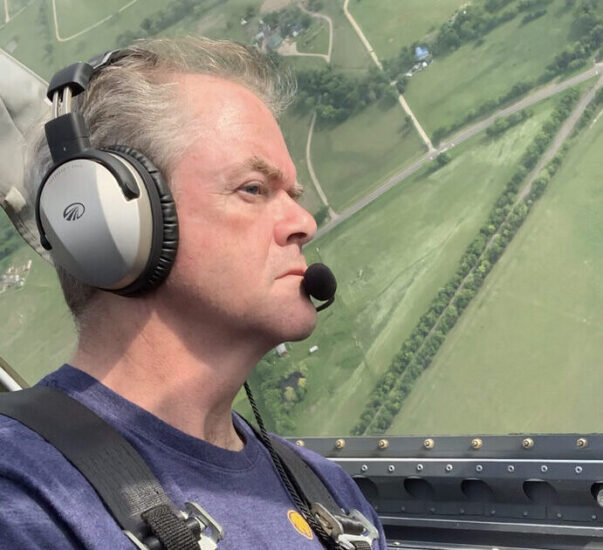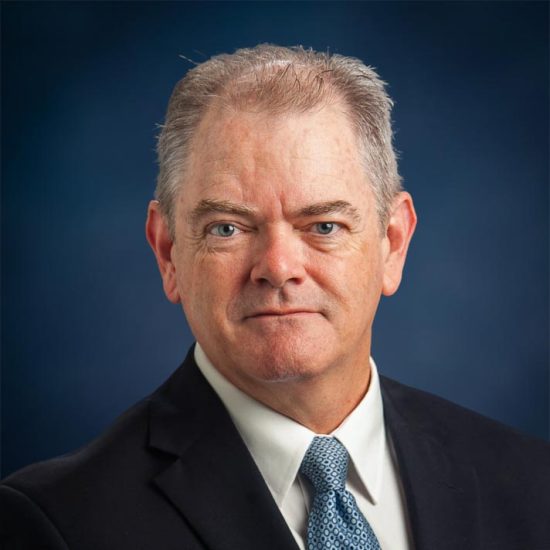
Flying is pretty easy – it’s the landings that are tricky.
Matt Wood, Ph.D. Regents Professor
- Faculty

Dr. Matt Wood is a man of many talents. From playing the bass guitar, biking and woodworking, he finds joy in a wide range of activities. Recently, he fulfilled a lifelong dream and earned his private pilot license. Wood and his partner enjoy taking his two-seater for sunset flights. When they long for the mountains, they hop in the plane and take a weekend trip! He grew up in Des Moines, Iowa, where education is paramount. He had several influential teachers on his academic journey and they helped to develop his love for astronomy. As a professor, Wood shares his knowledge and passion for astrophysics and astronomy with his students.
A Conversation with Dr. Matt Wood
What would you tell a student who is thinking about attending East Texas A&M?
We're known to be one of the most student-friendly departments on campus, and there is some stiff competition. We have a 400-square-foot peer learning lab informally known as the student lounge. We know many of our students commute, and this is their home away from home, complete with computers, desks, sofas, and kitchen facilities for those late-night study sessions. A big focus in our department in the past decade has been building community. We also encourage every student interested to get involved in research with a faculty member.
What do you enjoy most about your job?
I enjoy the personal interactions with students in and out of the classroom—seeing the students over their time with us as they grow from learning basic mechanics to mastering some fairly complicated computational physics simulations, for example, and the parallel growth in their own confidence in their abilities. Our department motto is: “We don't just study physics, we DO physics!”
What is a project that you are working on or have recently finished?
Recently, I've been working a lot with time-series photometry data from the NASA TESS and Kepler satellite missions, and am serving as the Scientific Director for the Center for Backyard Astrophysics (CBA; cbastro.org). The CBA is a global citizen-science network of small telescopes dedicated to the photometric study of cataclysmic variable (CV) stars which produces thousands of hours of time-series photometry of CVs every year. Cataclysmic variables are close binary star systems with orbital periods of 30 minutes to a few hours. Similar to how we can use seismology time-series measurements to study the interior structure of the Earth, we can use these time-series measurements of stars to probe the structure and evolution of the stars themselves—a field known as asteroseismology. We also have our own research-grade telescopes just south of campus which is the largest in East Texas with 24- and 27-inch apertures that our students use to collect data for analysis and publication. It's a great way for students to get into research, since the telescope is 100% ours and available every clear night.
What class have you taught that you enjoy better than others? What makes the material exciting?
My favorite class to teach is undergraduate “Stars and Stellar Evolution,” although our own Dr. Williams has been teaching that in recent years. This course ties together all the physics that students have learned, and applies it to understanding the structure and evolution of stars. From nuclear fusion and nucleosynthesis to atomic structure to fluid mechanics, stars do it all.
Tell me a little about yourself.
For many years, my primary hobby was playing music. I'm a bass player (progressive rock and jazz, preferably), but also play guitar reasonably well. I also enjoy woodworking, bicycling, and cooking, but lately I fulfilled a lifelong dream and earned my private pilot license. I purchased the plane that our own Dr. Kent Montgomery built but wasn't flying much anymore. The paint job he did is just fantastic. I get compliments everywhere I go. The plane is a two-seater, and my partner and I like to travel far and wide for sunset flights, the proverbial $100 hamburger (or BBQ), or visiting family and friends in Louisiana, New Mexico, or Colorado. Our flight time is usually 1/3 the drive time, which puts mountains within reach for a weekend trip. She also dreamed of learning to be a pilot, so it's fun to learn together. We also do a lot of traveling (using commercial aviation) with recent trips to the Pacific Northwest, Atlantic Northeast, Patagonia, and the Galápagos Islands.
Educational Background
- Ph.D., Astronomy, The University of Texas-Austin, 1990
- M.S., Astronomy, The University of Texas-Austin, 1985
- B.S., Physics, Iowa State University, 1983
Academic Positions
- Regents Professor of Physics and Astronomy, East Texas A&M University 2021-present
- Professor of Physics and Astronomy, East Texas A&M University, 2019-2021
- Vice Provost for Research and Dean of the Graduate School, East Texas A&M University, 2017-2019
- Department Head and Professor of Physics and Astronomy, East Texas A&M University, 2012-2017
- Visiting Scientist (Sabbatical), Radboud University-Nijmegen, 2008-2009
- Professor, Florida Institute of Technology, 1991-2012
Honors and Rewards
- Texas A&M University System Regents Professor, 2021
- Dr. Harry Wade Senior Faculty Award, 2021
- Faculty Senate Professional Service Award, 2020
- Outstanding Department Head, Texas A&M University-Commerce(now East Texas A&M University) Faculty Senate, 2015
- Distinguished Principal Investigator for Excellence in Research, Texas A&M University-Commerce, 2014
Research Interests
- Stellar astrophysics
- Astrophysical hydrodynamics
- Cataclysmic variables
- White dwarf stars
Professional Organizations
- American Association of Physics Teachers (AAPT)
- American Astronomical Society (AAS)
- Astronomical Society of the Pacific (ASP)
- International Astronomical Union (IAU)
- Royal Astronomical Society
Select Publications
- Wood, M. (2015). Python and Matplotlib Essentials for Scientists and Engineers. Morgan and Claypool Publishers.
- Ogunc, A., Scholten, P., & Wood, M. A. Using Python and Statsmodels for Principles of Econometrics, in preparation, available on Amazon Spring 2025.
- Duffy C., Wu K., Ramsay G., Wood M. A., Mason P. A., Hakala P., & Steeghs D., 2024, Characterizing high and low accretion states in VY Scl CVs using ZTF and TESS data, MNRAS.
- Patterson, J. et al. (includes Wood, M.A.), 2022, The Periodic Signals of Nova V1674 Her (2021), ApJL, 940, L56.
- Duffy C., Ramsay G., Wu K., Mason P. A., Hakala P., Steeghs D., & Wood M. A., 2022, Short-duration accretion states of Polars as seen in TESS and ZTF data, MNRAS, 516, 3144-3158
- Ramsay, G., Hakala, P., and Wood, M. A., 2021, Detection of an energetic flare from the M5V secondary star in the Polar MQ Draconis, MNRAS, 504, 4072-4076.
- Patterson, J., et al. (includes Wood, M.A.), 2020, The Spin-Period History of Intermediate Polars, ApJ, 897, 70.
- Patterson, J., et al. (includes Wood, M.A.), 2017, OV Bootis: Forty Nights of World-Wide Photometry, JAAVSO, 45, 224
- Ramsay, G., Wood, M. A., Cannizzo, J., Howell, S. & Smale, A. 2017, V729 Sgr: A long period dwarf nova showing negative superhumps during quiescence, MNRAS, 469, 950
- Boyd, D., de Miguel, E., Patterson, J., Wood, M., et al. (31 authors) 2017, A 16-yr photometric campaign on the eclipsing novalike variable DW Ursae Majoris, MNRAS, 466, 3417
- Cha, S. H., & Wood, M. A. 2016, GodunovSPH with Shear Viscosity: Implementation and Tests, MNRAS, 458, 480


